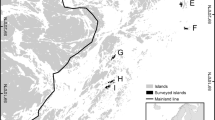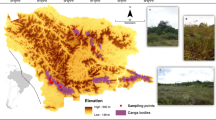Abstract
Context
Although there have been methodological advances in the analysis of biodiversity and landscape properties, most studies in landscape ecology primarily explore whether certain landscape properties, such as island area and isolation, have universal effects on species-centric measures.
Objectives
We assessed how landscape variables drive species richness, phylogenetic diversity (PD), and phylogenetic community structure. Moreover, we explored the dominant processes structuring plant community assembly, including phylogenetic community structure.
Methods
We used plant data from 235 uninhabited islands in the western and southern seas, South Korea. Species richness, Faith’s PD, and standardized effect size of mean pairwise phylogenetic distance (SES.MPD) were quantified for three plant groups, all, woody, and herbaceous plants for each island. Island area, distance from mainland, habitat heterogeneity, and structural connectivity were also calculated to examine the relationships between indices of plant diversity and community structure.
Results
The relative importance of landscape variables differed among indices of diversity and community structure as well as among plant groups. Island area and distance from mainland were the main drivers of species richness and PD across plant groups, whereas distance from mainland significantly affected community structure measured by SES.MPD. We found that the community structure in islands farther from mainland showed phylogenetic clustering patterns driven by niche-based deterministic processes across the three plant groups.
Conclusions
We found that community structure analysis provides more information related to ecological processes and assembly mechanisms than diversity indices alone. Therefore, we recommend that community structure analysis with plant diversity should be implemented as an additional measure of biodiversity for landscape ecology and for conservation planning in island ecosystems.


Similar content being viewed by others
References
Aggemyr E, Auffret AG, Jädergård L, Cousins AO (2018) Species richness and composition differ in response to landscape and biogeography. Landsc Ecol 33:2273–2284
Arjona Y, Nogales M, Heleno R, Vargas P (2018) Long-distance dispersal syndromes matter: diaspore-trait effect on shaping plant distribution across the Canary Islands. Ecography 41:805–814
Auffret AG, Rico Y, Bullock JM, Hooftman DAP, Pakeman RJ, Soons MB, Suárez-Esteban A, Traveset A, Wagner HH, Cousins SAO (2017) Plant functional connectivity-integrating landscape structure and effective dispersal. J Ecol 105:1648–1565
Braun-Blanquet J (1965) Plant sociology: the study of plant communities. Hafner Publishing, New York
Burbrink FT, McKelvy AD, Pyron RA, Myers EA (2015) Predicting community structure in snakes on eastern Nearctic islands using ecological neutral theory and phylogenetic methods. Proc R Soc B 282:20151700
Burnham KP, Anderson DR (2002) Model selection and inference: a practical information-theoretic approach, 2nd edn. Springer, New York
Capinha C, Marcolin F, Reino L (2020) Human-induced globalization of insular herpetofaunas. Glob Ecol Biogeogr 29:1328–1349
Carvajal-Endara S, Hendry AP, Emery NC, Davies TJ (2017) Habitat filtering not dispersal limitation shapes oceanic island floras: species assembly of the Galápagos archipelago. Ecol Lett 20:495–504
Chi Y, Shi H, Wang X, Qin X, Zheng W, Peng S (2016) Impact factors identification of spatial heterogeneity of herbaceous plant diversity on five southern islands of Miaodao Archipelago in North China. Chin J Oceanol Limnol 34:937–951
Chi Y, Sun J, Fu Z, Xie Z (2019) Spatial pattern of plant diversity in a group of uninhabited islands from the perspectives of island and site scales. Sci Total Environ 664:334–346
Cho Y, Kim Y, Lim HM, Han YG, Choi MJ, Nam SH (2011) A faunistic study of insects of uninhabited islands in the Docho-myeon, Sinan-gun, Jeollanam-do, Korea. Korean J Envrion Ecol 25:673–684
Chun JH, Lee CB (2018) Partitioning the regional and local drivers of phylogenetic and functional diversity along temperate elevational gradients on an East Asian peninsula. Sci Rep 8:2853
Chun JH, Lee CB (2019) Temporal changes in species, phylogenetic, and functional diversity of temperate tree communities: insight from assembly patterns. Front Plant Sci 10:294
Chun JH, Ali A, Lee CB (2020) Topography and forest diversity facets regulate overstory and understory aboveground biomass in a temperate forest of South Korea. Sci Total Environ 744:140783
Dale S (2019) Islands in the forest: effects of patch size and isolation on farmland bird species richness and community composition of farmland patches in forest landscapes. Landsc Ecol 34:2823–2836
Edelsparre AH, Shahid A, Fitzpatrick MJ (2018) Habitat connectivity is determined by the scale of habitat loss and dispersal strategy. Ecol Evol 8:5508–5514
Eldridge MDB, Meek PD, Johnson RN (2014) Taxonomic uncertainty and the loss of biodiversity on Christmas Island, Indian Ocean. Conserv Biol 28:572–579
Faith DP (1992) Conservation evaluation and phylogenetic diversity. Biol Conserv 61:1–10
Graham MH (2003) Confronting multicollinearity in ecological multiple regression. Ecology 84:2809–2815
Graham CH, Fine PVA (2008) Phylogenetic beta diversity: linking ecological and evolutionary processes across space in time. Ecol Lett 11:1265–1277
Hortal J, Triantis KA, Meiri S, Thébault E, Sfenthourakis S (2009) Island species richness increases with habitat diversity. Am Nat 174:E205–217
Jin Y, Qian H (2019) V.PhyloMaker: an R package that can generate very large phylogenies for vascular plants. Ecography 42:1353–1359
Kalmar A, Currie DJ (2006) A global model of island biogeography. Global Ecol Biogeogr 15:72–81
Kim HH, Kim DB, Jeon CH, Kim CS, Kong WS (2017) Island biogeographical characteristics of naturalized plant in Jeollanamdo islands. Korean J Environ Impact Assess 26:273–290
Lee HJ, Cho KM, Hong SK, Kim JE, Kim KW, Lee KA, Moon KO (2010) Management plan for UNESCO Shinan Dadohae Biosphere Reserve (SDBR), Republic of Korea: integrative perspective on ecosystem and human resources. J Ecol Field Biol 32:95–103
Lee CB, Chun JH, Ahn HH (2014) Elevational patterns of plant richness and their drivers on an Asian mountain. Nord J Bot 32:347–357
Legendre P, Legendre L (1998) Numerical ecology. Elsevier, Amsterdam
Li S, Wang P, Chen Y, Wilson MC, Yang X, Ma C, Lu J, Chen X, Wu J, Shu W, Jiang L (2020) Island biogeography of soil bacteria and fungi: similar patterns, but different mechanisms. ISME J 14:1886–1896
Lindborg R, Helm A, Bommarco R, Heikkinen RK, Kühn I, Pykälä J, Pärtel M (2012) Effect of habitat area and isolation on plant trait distribution in European forests and grasslands. Ecography 35:356–363
Losos JB, Schluter D (2000) Analysis of an evolutionary species-area relationship. Nature 408:847–850
MacArthur RH, MacArthur JW (1961) On bird species diversity. Ecology 42:594–598
MacArthur RH, Wilson EO (1967) The theory of island biogeography. Princeton University Press, Princeton
Marx HE, Dentant C, Renaud J, Delunel R, Tank DC, Lavergne S (2017) Rider in the sky (islands): using a mega-phylogenetic approach to understand plant species distribution and coexistence at the altitudinal limits of angiosperm plant life. J Biogeogr 44:2618–2630
Mayfield MM, Levine JM (2010) Opposing effects of competitive exclusive on the phylogenetic structure of communities. Ecol Lett 13:1085–1093
Moilanen A, Nieminen M (2002) Simple connectivity measures in spatial ecology. Ecology 83:1131–1145
Morinière J, Van Dam MH, Hawlitschek O, Bergsten J, Michat MC, Hendrich L, Ribera I, Toussaint EFA, Balke M (2016) Phylogenetic niche conservatism explains an inverse latitudinal diversity gradient in freshwater anthropods. Sci Rep 6:26340
Nogué S, de Nascimento L, Foryd CA, Wilmshurst JM, de Boer EJ, Coffey EED, Whittaker RJ, Fernández-Palacios JM, Willis KJ (2017) Island biodiversity conservation needs paleoecology. Nat Ecol Evol 1:181
Panitsa M, Tzanoudakis D, Triantis KA, Sfenthourakis S (2006) Patterns of species richness on very small islands: the plants of the Aegean archipelago. J Biogeogr 33:1223–1234
Portillo JTM, Ouchi-Melo LS, Crivellari LB, de Oliveira TAL, Sawaya RJ, Duarte LS (2019) Area and distance from mainland affect in different ways richness and phylogenetic diversity of snakes in Atlantic Forest coastal islands. Ecol Evol 9:3909–3917
Potter KM (2009) From genes to ecosystems: measuring evolutionary diversity and community structure with Forest Inventory and Analysis (FIA) data. In 2008 Forest Inventory and Analysis (FIA) symposium, 2008 October 21–23, Park City, UT. USDA For. Serv., Proc. RMRS-P-56CD, Rocky Mountain Research Station, Fort Collins, CO. pp 16
Qian H, Hao Z, Zhang J (2014) Phylogenetic structure and phylogenetic diversity of angiosperm assemblages in forests along an elevational gradient in Changbaishan, China. J Plant Ecol 7:154–165
Rodrigues ASL, Gaston KJ (2002) Maximizing phylogenetic diversity in the selection of networks of conservation areas. Biol Conserv 105:103–111
Ross SRPJ, Friedman NR, Janicki J, Economo EP (2019) A test of trophic and functional island biogeography theory with the avifauna of a continental archipelago. J Anim Ecol 88:1392–1405
Si X, Cadotte MW, Baselga A, Zhao Y, Li J, Wu Y, Wang S, Ding P (2017) Functional and phylogenetic structure of island bird communities. J Anim Ecol 86:532–542
Spanowicz AG, Jaeger JAG (2019) Measuring landscape connectivity: on the importance of within-patch connectivity. Landsc Ecol 34:2261–2278
Swenson NG, Erickson DL, Mi X, Bourg NA, Forero-Montaña J, Ge X, Howe R, Lake JK, Liu X, Ma K, Pei N, Thompson J, Uriarte M, Wolf A, Wright SJ, Ye W, Zhang J, Zimmerman JK, Kress WJ (2012) Phylogenetic and functional alpha and beta diversity in temperate and tropical tree communities. Ecology 93:S112–S125
Webb CO, Ackerly DD, McPeek MA, Donoghue MJ (2002) Phylogenies and community ecology. Annu Rev Ecol Syst 33:475–505
Acknowledgements
This study was conducted with the support of “R&D Program for Forest Science Technology (Project No. 2019150C10-1923-0301)” provided by Korea Forest Service (Korea Forestry Promotion Institute). This study was also supported by the National Research Foundation of Korea (NRF) grant funded by the Korea government (MSIT) (No. 2020R1A2C2011226).
Author information
Authors and Affiliations
Corresponding author
Additional information
Publisher's Note
Springer Nature remains neutral with regard to jurisdictional claims in published maps and institutional affiliations.
Electronic supplementary material
Below is the link to the electronic supplementary material.
Rights and permissions
About this article
Cite this article
Kim, H., Lee, CB. On the relative importance of landscape variables to plant diversity and phylogenetic community structure on uninhabited islands, South Korea. Landscape Ecol 36, 209–221 (2021). https://doi.org/10.1007/s10980-020-01134-1
Received:
Accepted:
Published:
Issue Date:
DOI: https://doi.org/10.1007/s10980-020-01134-1




